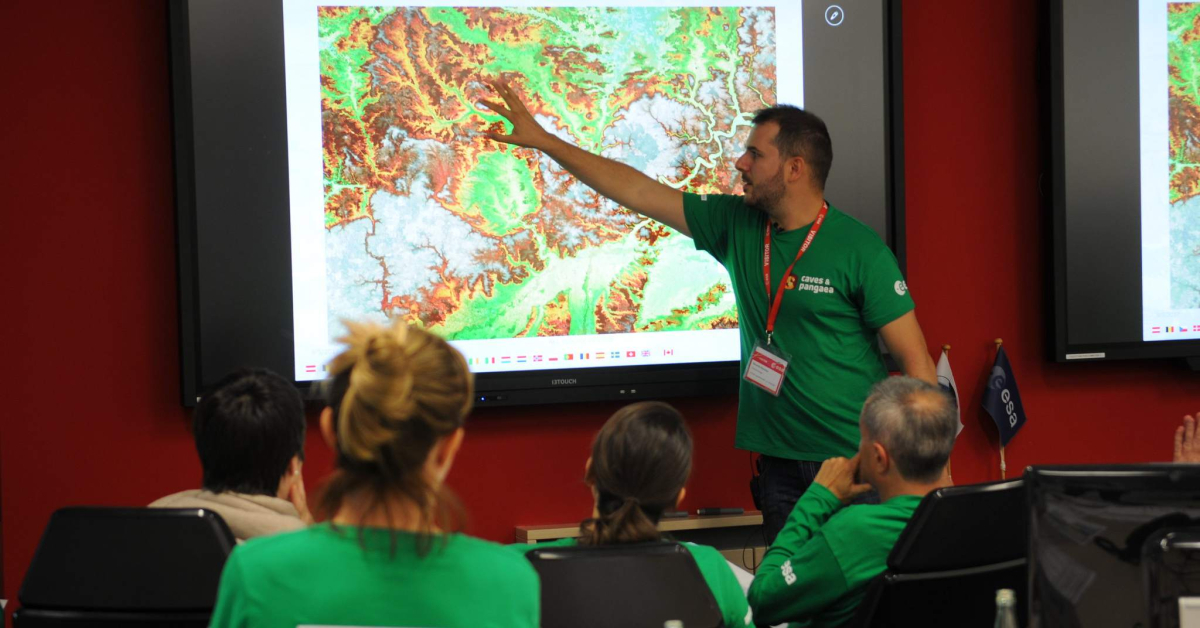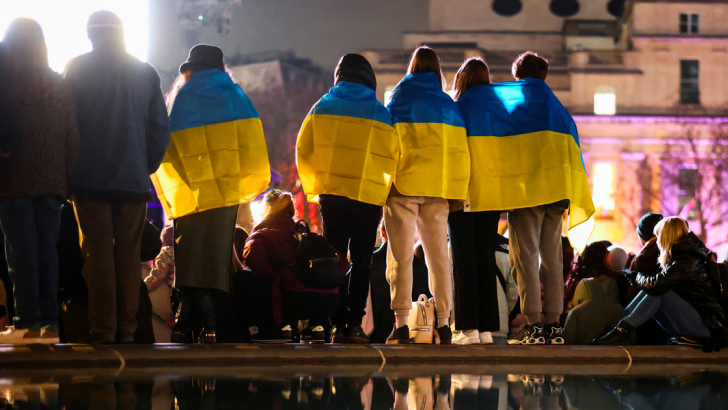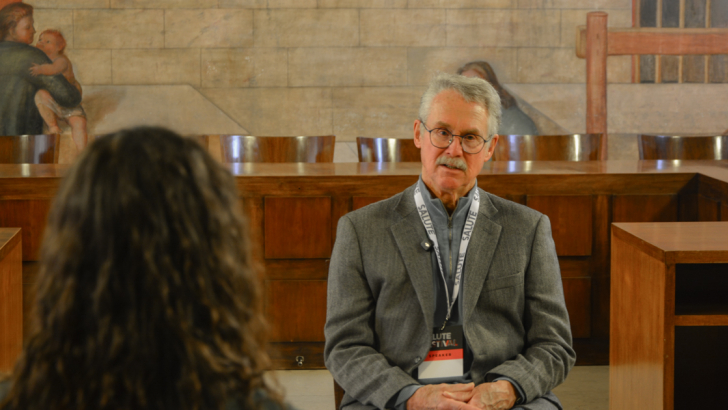The scientific legacy of Riccardo Pozzobon

Riccardo Pozzobon during a lecture in the Pangaea course for astronauts. Credits: Esa – Elena Díaz
They set out on August 26th for Alaska. Their goal was to study the fractures of the glaciers in the Juneau Icefield – one of the largest icefields in the world – in order to better understand the deformations and crustal depths of icy satellites, such as Ganymede or Enceladus, which orbit Jupiter and Saturn. The movement of Earth's glaciers generates fractures similar to those detected on frozen satellites. Studying these terrestrial analogues, therefore, allows us to understand better what happens in outer space. The Gemini project (Glacial Environment deformation Mechanisms to INfer Icy satellites tectonics) included Riccardo Pozzobon, a planetary geologist at the university of Padua, along with other scientists. The team's task was to conduct field surveys and satellite observations in order to produce multiscale cartographies. After several days of regular work, tragedy struck: on September 2nd, while attempting to retrieve an object that had fallen during lunch, Pozzobon is thought to have stumbled and slipped into a stream on the Mendenhall Glacier. The current then dragged him into an ice moulin.
A researcher in the department of Geosciences at the university of Padua, Pozzobon had left for Alaska, bringing years of experience in study and fieldwork behind him, along with a rich record of scientific contributions developed through national and international collaborations.

“Riccardo began his career studying deformations linked to planetary volcanoes, using digital surveying methods and modelling techniques – recalls Matteo Massironi, professor of geology in Padua, who had worked with the young researcher for many years –. Later, together with our colleague Francesco Mazzarini from the Italian National Institute of Geophysics and Volcanology, he focused on analysing the fractal distribution of fractures to understand the depth of magmatic sources better. Pozzobon, Mazzarini and me, first applied this methodological approach to the study of Mars. Later, we extended this research – always with Riccardo's contribution – to icy bodies as well. It was at this point that the first studies aimed at understanding the thickness of the icy crust covering the internal oceans of outer planetary bodies, such as Jupiter's moons, began. Ganymede is one such example, but we can also mention Enceladus. These studies were primarily conducted in collaboration with researchers from Inaf. In fact, Riccardo's model is now consistently applied to study the depth of magmatic sources in volcanic areas, the thickness of icy crusts, and even the water sources that feed the mud volcanoes on Mars."
Pozzobon was also a guest in the studios of Il Bo Live, where he spoke about a 2024 “Nature Astronomy” paper: the first direct evidence of lava tubes on the Moon
Massironi continues: "Then there was the important work on lava tubes, which Riccardo pursued together with Francesco Sauro and me. This work is probably his most famous contribution, also because it is the most recent. The story began some time ago, with the first high-resolution images of the Moon taken by Japan's Selene/Kaguya mission. Thanks to those images, Junichi Haruyama and co-authors identified in the Marius Hills the first surface openings that might correspond to underground lava tunnels". These were surface collapses suggesting the presence of subterranean caves: that was the hypothesis, but conclusive proof was still lacking.
“These pits were then studied from a morphological and morphometric perspective, using a method developed by Pozzobon. What emerged was that the cavities thought to exist beneath the surfaces of the Moon and Mars are much larger than analogous ones on Earth". Data collected indicated that Martian and lunar lava tubes are between one and three orders of magnitude more voluminous than their terrestrial counterparts. The results were published in Earth-Science Reviews. While terrestrial tubes reach 10–30 meters in diameter, on Mars they can be 10 times larger, and on the Moon, 100 times larger.
Research in this direction continued, leading in 2024 to the first direct evidence of underground caves and lava tunnels on the Moon. “With this study – Pozzobon explained in a video interview with Il Bo Live – for the first time we were really able to see through the darkness". When he arrived in the newsroom for that interview, he had just returned from a scientific mission to the Lofoten Islands in Norway. Despite his fatigue, he did not attempt to hide his satisfaction at having helped bring about the discovery. With passion and generosity, he shared the details of the research enthusiastically.
Francesco Sauro, speleologist and researcher at the university of Padua’s department of Geosciences, who took part in many missions with Pozzobon, stresses: “That discovery would not have been possible without Riccardo. It was published in Nature Astronomy and, within just a few days, it made headlines worldwide. In a month, the scientific paper became one of the most read in the entire Nature series. It offered a completely new perspective on the Moon, one that went beyond the knowledge we had acquired until then, and we were, and still are, very proud of it. Riccardo was especially proud”.
Sauro adds that Pozzobon was also working intensively with the European Space Agency (Esa) and the Italian Space Agency to support future lunar missions, to explore lava caves using robots or other instruments capable of entering them and analysing their characteristics. These structures could prove essential for building lunar bases, which would be protected from cosmic radiation and micrometeorite impacts. And not only on the Moon: on Mars, similar subterranean environments might even offer favourable conditions for life, which would be impossible to sustain on the planet's surface due to excessive ultraviolet radiation.

“His contribution was visionary: often our ideas were born from shared discussions, but he was the key to correctly interpreting the satellite data, thanks to his brilliant insights that made these discoveries possible”.
The speleologist continues: “Riccardo also had extraordinary skills in GIS (Geographic Information Systems), image analysis and 3D modelling, without which many of our studies could not have been carried out. He was the reference point when we returned from the field: he was responsible for collecting, processing and interpreting the data. For this reason, he had become a central figure for many professors and researchers. Many turned to him for support – some with data to visualise, others seeking advice on how to interpret it. And he was always available, often working late into the night to answer the scientific questions that were put to him”.
Even on this latest mission to Alaska, Riccardo played a crucial role. “Having him on the team meant not only collecting the data, but also being sure that those data would be interpreted and used to generate knowledge. This step is essential and not at all obvious: it is one thing to climb a volcano to take samples and analyse them, another to extract the useful information for research truly. And in this Riccardo was undoubtedly special”.
Beyond being a prolific researcher, he was also a highly appreciated lecturer. He taught digital geological mapping to students. But that was not all. He coordinated every edition of the Geology and Planetary Mapping Virtual Winter School, which, each year, was attended by hundreds of participants from all over the world. As part of the Esa's Pangaea program, designed to provide astronauts with knowledge of field and planetary geology, Pozzobon was active both in the classroom and in the field, helping to coordinate scientific operations during geological traverses. These activities aim to train a new generation of space explorers capable of examining the geology and topography of alien environments using the classical field geologist's method, in preparation for future space missions. Students in recent years have included Esa astronauts Luca Parmitano, Matthias Maurer, Samantha Cristoforetti, and Alexander Gerst, as well as Nasa astronauts Kathleen Rubins and Stephanie Wilson.
“For him, geology was a passion – said Luca Parmitano in an interview with Corriere della Sera on September 7th –. He was incredibly skilled at helping us understand environmental realities. He was generous in sharing his expertise, and that made our task easier as we faced the new challenges ahead. His enthusiasm was contagious. When you were with him, you felt you were with a friend. Smiling, he radiated warmth and good humour, the ideal companion for embarking on new and not always easy experiences”.
Colleagues and friends have launched an online fundraising campaign in support of Riccardo’s family, with the help of the La Venta Associazione: buonacausa.org/cause/riccardopozzobon
All funds go directly to the family, without any intermediaries.
This article was originally written in Italian. Since Il Bo Live does not have native English speakers on staff, we edited the text with the support of an AI-based language tool.
Questo articolo è stato scritto originariamente in italiano. Poiché nella redazione de Il Bo Live non ci sono madrelingua inglesi, abbiamo rivisto il testo con il supporto di uno strumento linguistico AI.









